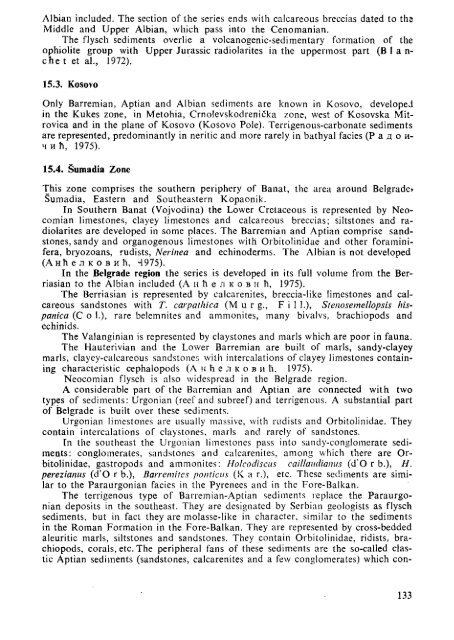THE MEDITERRANEAN LOWER CRETACEOUS
THE MEDITERRANEAN LOWER CRETACEOUS
THE MEDITERRANEAN LOWER CRETACEOUS
Create successful ePaper yourself
Turn your PDF publications into a flip-book with our unique Google optimized e-Paper software.
Albian included. The section of the series ends with calcareous breccias dated to the<br />
Middle and Upper Albian, which pass into the Cenomanian.<br />
The flysch sediments overlie a volcanogenic-sedimentary formation of the<br />
ophiolite group with Upper Jurassic radiolarites in the uppermost part (В I a nche<br />
t et al., 1972).<br />
15.3. Kosovo<br />
Only Barremian, Aptian and Albian sediments are known in Kosovo, developed<br />
in the Kukes zone, in Metohia, Crnolevskodrenicka zone, west of Kosovska Mitrovica<br />
and in the plane of Kosovo (Kosovo Pole). Terrigenous-carbonate sediments<br />
are represented, predominantly in neritic and more rarely in bathyal facies (Радойчип,<br />
1975).<br />
15.4. Sumadia Zone<br />
This zone comprises the southern periphery of Banat, the area around Belgrade»<br />
Sumadia, Eastern and Southeastern Kopaonik.<br />
In Southern Banat (Vojvodina) the Lower Cretaceous is represented by Neocomian<br />
limestones, clayey limestones and calcareous breccias; siltstones and radiolarites<br />
are developed in some places. The Barremian and Aptian comprise sandstones,<br />
sandy and organogenous limestones with Orbitolinidae and other foraminifera,<br />
bryozoans, rudists, Nerinea and echinoderms. The Albian is not developed<br />
(Анпелковип, 4975).<br />
In the Belgrade region the series is developed in its full volume from the Berriasian<br />
to the Albian included (А н h e л к о в и h, 1975).<br />
The Berriasian is represented by calcarenites, breccia-like limestones and calcareous<br />
sandstones with T. carpathica (M u r g., Fill.), Stenosemellopsis hispanica<br />
(С о 1.), rare belemnites and ammonites, many bivalvs, brachiopods and<br />
echinids.<br />
The Valanginian is represented by claystones and marls which are poor in fauna.<br />
The Hauterivian and the Lower Barremian are built of marls, sandy-clayey<br />
marls, clayey-calcareous sandstones with intercalations of clayey limestones containing<br />
characteristic cephalopods (А и h e л к о в и h, 1975).<br />
Neocomian flysch is also widespread in the Belgrade region.<br />
A considerable part of the Barremian and Aptian are connected with two<br />
types of sediments: Urgonian (reef and subreef) and terrigenous. A substantial part<br />
of Belgrade is built over these sediments.<br />
Urgonian limestones are usually massive, with rudists and Orbitolinidae. They<br />
contain intercalations of claystones, marls and rarely of sandstones.<br />
In the southeast the Urgonian limestones pass into sandy-conglomerate sediments:<br />
conglomerates, sandstones and calcarenites, among which there are Orbitolinidae,<br />
gastropods and ammonites: Holcodiscus caillaudianus (d'Orb.), H.<br />
perezianus (d'O г b\), Barremites ponticus (1С а г.), etc. These sediments are similar<br />
to the Paraurgonian facies in the Pyrenees and in the Fore-Balkan.<br />
The terrigenous type of Barremian-Aptian sediments replace the Paraurgonian<br />
deposits in the southeast. They are designated by Serbian geologists as flysch<br />
sediments, but in fact they are molasse-like in character, similar to the sediments<br />
in the Roman Formation in the Fore-Balkan. They are represented by cross-bedded<br />
aleuritic marls, siltstones and sandstones. They contain Orbitolinidae, ridists, brachiopods,<br />
corals, etc. The peripheral fans of these sediments are the so-called clastic<br />
Aptian sediments (sandstones, calcarenites and a few conglomerates) which con-<br />
133

















